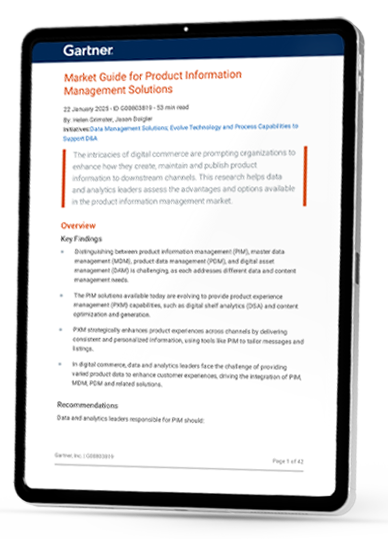
Why are so many businesses moving away from expensive, all-in-one software suites?
A “one-size-fits-all” approach rarely matches every business’s needs. These large software packages might offer everything together, but they often force companies to adapt their processes to fit the software, rather than the software fitting the business.
Packaged Business Capabilities (PBCs) offer a better way.
With PBCs, you can choose the best software module for each business function, such as product data, pricing, or order management. You connect these modules to build a custom solution that suits your company perfectly.
It is like building with LEGO bricks. Each piece serves a clear purpose, and together they create a system tailored to your needs, without compromise.
But here’s the challenge: With so many software choices available, how do you select the right Packaged Business Capabilities without ending up with a confusing mix of disconnected tools?

DOWNLOAD FREE E-BOOK
2025 Market Guide for PIM Solutions
The 2025 Market Guide by Gartner® will help data and analytics leaders understand the benefits and choices in the PIM market.
What Are Packaged Business Capabilities (PBCs)?
Packaged Business Capabilities (PBCs) are software components designed to fulfil specific business functions.
Each PBC operates as an independent module, allowing it to be designed, assembled, and deployed separately. This modularity means PBCs can be integrated or removed with ease across a range of applications or platforms.
From a business management perspective, PBCs address defined requirements and capabilities, such as centralised product information management, data distribution across sales channels, website content management, or order and payment processing.
From a technology standpoint, PBCs bring together different solutions or microservices to deliver these capabilities seamlessly.
Why Are PBCs So Important?
Today’s businesses can’t afford to be locked into slow-moving, one-size-fits-all systems.
Packaged Business Capabilities empower organisations to:
-
Customise technology stacks: Select only the components you need and integrate them easily.
-
Respond faster to change: Add, swap, or upgrade business functions with minimal risk.
-
Reduce complexity: Replace tangled, legacy integrations with clean, modular connections.
Composable architecture powered by PBCs means your digital strategy evolves as fast as your market.
What Makes a PBC Different from Microservices or Monolithic Platforms?
Packaged Business Capabilities (PBCs) and microservices are related concepts, but they are not the same and serve different purposes in modern IT architecture.
What Are Microservices?
Microservices are small, independent software services that each perform a single, specific task. They are developer-focused and communicate with other services via APIs. A microservice could handle authentication, payments, or inventory—just one piece of a bigger system.
Packaged Business Capabilities focus on business needs. Each PBC represents a complete business process—such as order management, pricing, or campaign management.
A PBC is typically made up of several microservices bundled together, with clear business logic, data schemas, and an API designed for business users and IT teams alike. PBCs are built using microservices. Multiple microservices are combined and orchestrated to deliver a full business capability as a single module.
In some cases, a PBC could also be delivered by a well-integrated monolithic application, as long as it exposes robust APIs and meets modular integration standards.
Product data chaos? Not on our watch.
Sign up for practical tips that help you launch faster, sell smarter, and finally get your product info under control.
The strength of this approach lies in its capacity to empower business and operational executives and managers to shape technological solutions and engage various stakeholders without needing an extensive grasp of technological complexities.
This enables ongoing adaptation, expansion, scaling, or modification of Composable solutions to address evolving business needs, improve identified areas, innovate, and swiftly seize new market opportunities and technologies, such as AI.
The stakes are high in light of the constantly evolving landscape of customer behavior and the advent of new marketing channels. It is imperative for companies to take proactive measures to establish fresh touchpoints with their customers, especially if they cater to younger audiences.
As Think with Google reports in “The future of retail: Global trends shaping the next 5 years”, younger shoppers are 2x to 3x as likely to have shopped using emerging media.
This presents a significant opportunity, not only for introducing products through new channels but also for building a stronger connection with customers, thereby fostering loyalty.

DOWNLOAD FREE E-BOOK
How Top Retailers Use AI: 7 Use Cases
Packed with real examples, practical tips, and the tools behind the strategies, this e-book is a must-read for retail and e-commerce leaders who want AI to really work for their business.
Benefits of Using PBCs and Composable Commerce
Employing PBCs and adopting the Composable approach to building your technology stack brings numerous benefits:
-
Solves business problems — they provide tailored software solutions to address specific business needs.
-
Improves customer experience — they enable businesses to deliver superior customer experiences across all touchpoints, facilitating product data syndication and tapping into new sales channels and geographic locations.
-
Streamlines work — well-designed PBCs establish more efficient workflows across departments, eliminating software function overlap and defining clear roles for specific software usage.
-
Automates tasks — by selecting software that eliminates repetitive tasks and streamlines the distribution and synchronization of product data, you can automate many processes, saving time and resources.
-
Promotes agility and innovation — the modular setup of Composable allows for quick changes and exploration of new business opportunities by defining or redefining PBCs.
-
Delivers Return on Investment — Composable Commerce, with well-designed PBCs, optimizes operations, reduces the total cost of ownership of software, and accelerates time to market, offering a substantial return on investment.
How to Design Packaged Business Capabilities: Practical Example
Let us put that knowledge into practice and use an example to demonstrate how you can design PBCs for your organisation.
Imagine ShopperSpot, a hypothetical online retailer looking to move away from their restrictive all-in-one solution and embrace the flexibility of Composable Commerce, using PBCs.
The eCommerce Managers at ShopperSpot have identified key features and functionalities they need, including PBCs for:
-
Managing product information,
-
Handling orders,
-
Managing customers,
-
Processing payments,
-
Analytics and reporting,
-
Managing promotions and discounts.
ShopperSpot has designed the following PBCs, each offering API connectivity for smooth integration with other PBCs. They also understand that as they identify new needs, they have the flexibility to create more PBCs and seamlessly integrate them into the system.
Whether adding new PBCs or modifying existing ones, ShopperSpot always has the option to change their technology, for example by including PBCs for customer support, procurement, and content management.

Importance of Business Perspective in Designing PBCs
The involvement of business leaders is essential for designing effective PBCs.
With their comprehensive understanding of organizational dynamics, executives and managers possess invaluable insights into operational intricacies, customer demands, and overarching business objectives.
Additionally, business leaders help identify potential challenges and opportunities, ensuring that PBCs are not only technically sound but also practical and effective in real-world situations.
This fosters support and ownership of PBCs across the organization, meaning that everyone is on board and invested in making the new capabilities work.
How to Implement Your PBCs
As an executive or business manager, you may be considering the implementation of a Composable solution.
While confident in defining your company's required capabilities, identifying suitable software can pose a significant technical challenge, particularly when dealing with intricate aspects such as microservices or API connectivity, which demand specialized knowledge in IT.
The good news is that microservice-based and composable applications are widely recognized and embraced by IT specialists. However, the primary hurdle lies in acquiring the necessary skills to select and seamlessly integrate the best fitting solutions for delivering the desired capabilities.
If your organization lacks some of these skills, it should not deter you from reaping the benefits of using PBCs and Composable Commerce, as you can always leverage external support.
When implementing your PBCs to create a Composable Commerce solution, you have two main options:
-
Pre-packaged (Accelerator): This type of Composable Commerce solution offers a predefined set of PBCs that cover various common use cases. Typically provided by IT consultancies, systems integrators (SI), and independent software vendors (ISV) specializing in the Composable approach. While adjustments, replacements, or ongoing additions of components are possible, businesses with highly unique needs may find a custom option more suitable.
-
Custom-designed: In this scenario, the solution is tailored entirely to your enterprise requirements. This can be accomplished internally if your organization has the necessary expertise, or externally by hiring companies specializing in Composable solutions. The decision between internal and external approaches depends on the availability of skilled specialists and the complexity of your customization needs.
Accelerators vs Best-of-suite Solutions
Composable accelerators stand out for their flexibility and quick implementation, rivaling traditional best-of-suite solutions offered by single, large vendors.
Accelerators empower organisations to swap out any component without fear of vendor lock-in, allowing for process optimisation, enhanced efficiency, and adaptation to evolving business needs while retaining control over the technology stack. This simplifies the daunting task of evaluating, selecting, and purchasing multiple software solutions.
Specialised companies offering accelerators not only provide powerful tools but also offer immediate guidance, best practices, and training materials.
This ensures that your enterprise is equipped with cutting-edge technology and can quickly adopt and effectively utilise it.
Start with a PBC for Product Information Management
In the realm of Composable Commerce, Product Information Management (PIM) systems have emerged as the keystone for building robust and efficient solutions.
This may surprise some, as in the past, PIM systems were often overlooked or seen as less important compared to Master Data Management (MDM) or Enterprise Resource Planning (ERP) systems.
However, with the increase in data complexity and distribution channels, relying on limited integrations, spreadsheets, or manual data entry became problematic. PIM systems have become the best solution to these challenges, offering a centralized source for all product data.
A Composable PIM allows you to establish a PBC that serves as the central hub for your product data, ensuring completeness and quality. It enables teams and partners to access relevant data for collaborative management. This enriched product data can then be syndicated across all systems and customer channels.
Therefore, whether you are aiming to develop a basic or highly complex solution, the initial step is to establish a PBC for centralizing your product data. This ensures a secure and efficient handling of your data, allowing for extensive modifications to various PBCs while maintaining the integrity of your product content.
Choosing a different approach carries risks, as spreading your data across different systems or locations can lead to inconsistencies and difficulties in its management. So, starting with a centralized source for product information reduces the likelihood of discrepancies.
Moreover, PIM can significantly impact the performance of the whole Composable solution. Transferring large amounts of data for millions of SKUs, digital assets, and real-time data requires a very capable and mature system.
Inferior and non-enterprise-level PIM systems or a lack of PIM may result in very slow data transfer and prolonged synchronization lasting days instead of hours. This will lead to a slower time-to-market due to the delayed flow of accurate and up-to-date data.
Frequently Asked Questions About PBC and Composable Commerce
1. Will Implementing PBCs and Composable Commerce Disrupt the Work of Various Departments and Pose a Risk of Failure?
This is an important question that may concern many business leaders who are considering transitioning from monolithic and best-of-suite solutions to Composable solutions.
The strength of the Composable approach lies in its inherent flexibility, enabling you to implement it at your own pace through iterative adjustments. If you still want to keep some of your monolithic software solutions, you can adopt a hybrid approach by defining PBCs that would be better served with a Composable solution, and start there, for example, with a PBC for centralizing product information using a Composable PIM.
Involving stakeholders from different departments to identify their required functions encourages collaboration and minimizes potential risks. Using PBCs to demonstrate how these requirements can be met facilitates step-by-step design and development of your solution.
If you have clearly outlined the business capabilities required, you essentially have a roadmap for success.
Whether opting for significant strides or beginning with small steps to gauge the waters, gaining firsthand experience with PBCs and the Composable approach boosts confidence in introducing or expanding upon existing PBCs.
2. How Can We Effectively Implement PBCs and Composable Commerce When We Lack the Necessary Expertise?
Organizations lacking expertise can entrust it to external companies specializing in Composable Commerce, such as consultancies, independent software vendors, and system integration firms, while still maintaining significant control over the design of their solutions thanks to PBCs.
This means that executives, managers, or strategists can closely collaborate with in-house IT specialists to determine the necessary services to fulfill their needs.
While external experts handle the more demanding technical aspects, organizations can actively contribute to the design and direction of their Composable solution, ensuring it aligns closely with their vision and objectives.
Summary
Packaged Business Capabilities are a powerful framework for unlocking business potential and succeeding in today's rapidly evolving business landscape.
By understanding the benefits, principles and best practices of PBCs, organizations can harness their transformative potential to create superior customer experiences, accelerate innovation and stay ahead of the competition.
Whether you are just getting started with PBCs or want to take your existing capabilities to the next level, now is the time to embrace the future of business and embark on a journey toward efficiency, sustained growth, and innovation.
Do you have questions about Composable Commerce and PIM? Get in touch with our PIM advisors today to schedule a free consultation or schedule a personalized demo meeting and discover the possibilities of Bluestone PIM, the leading Composable PIM solution.




